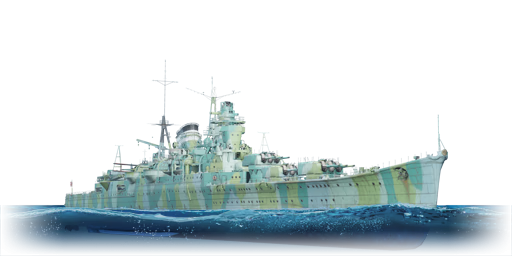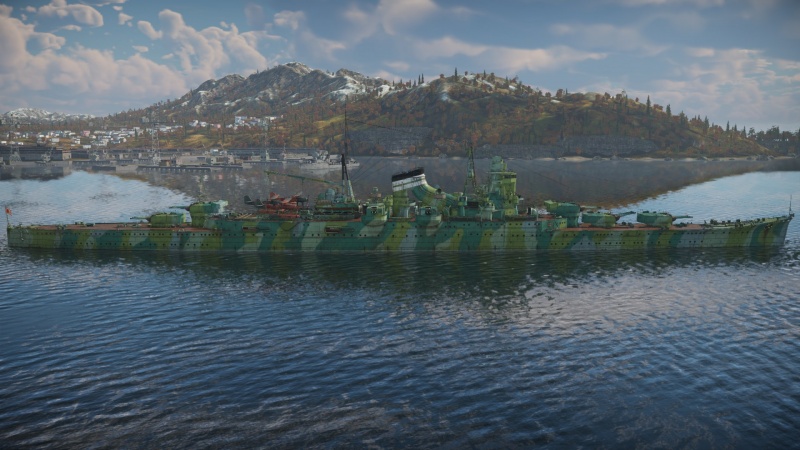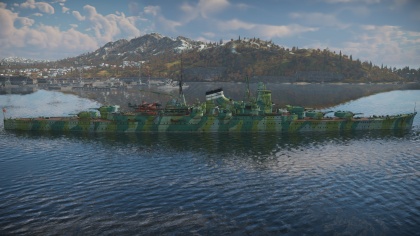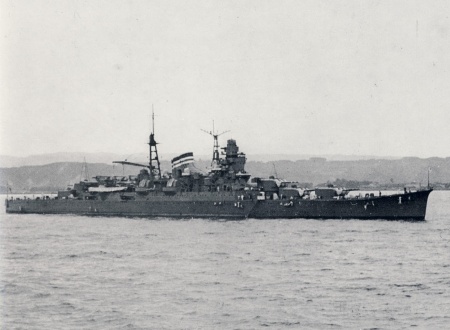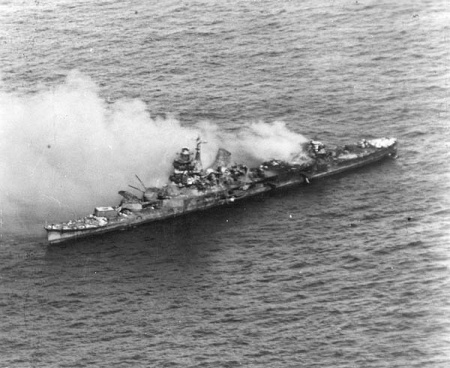Difference between revisions of "IJN Mikuma"
Bonisducks (talk | contribs) (→History: History and references.) (Tag: Visual edit) |
|||
| Line 149: | Line 149: | ||
* ''links to approximate analogues of other nations and research trees.'' | * ''links to approximate analogues of other nations and research trees.'' | ||
| − | == External links ==<!-- Paste links to sources and external resources, such as: | + | == External links == |
| − | + | <!-- ''Paste links to sources and external resources, such as:'' | |
| − | topic on the official game forum; | + | * ''topic on the official game forum;'' |
| − | encyclopedia page on the ship; | + | * ''encyclopedia page on the ship;'' |
| − | other literature. --> | + | * ''other literature.'' --> |
=== References === | === References === | ||
Revision as of 15:20, 13 January 2021
Contents
| This page is about the premium Japanese light cruiser IJN Mikuma. For other uses, see Mogami (Family). |
Description
The Mogami-class, IJN Mikuma, 1939 is a premium rank V Japanese light cruiser
with a battle rating of 6.0 (AB/RB/SB). It was introduced in Update 1.97 "Viking Fury".
General info
Survivability and armour
Talk about the vehicle's armour. Note the most well-defended and most vulnerable zones, e.g. the ammo magazine. Evaluate the composition of components and assemblies responsible for movement and manoeuvrability. Evaluate the survivability of the primary and secondary armaments separately. Don't forget to mention the size of the crew, which plays an important role in fleet mechanics. Save tips on preserving survivability for the "Usage in battles" section. If necessary, use a graphical template to show the most well-protected or most vulnerable points in the armour.
Mobility
Write about the ship's mobility. Evaluate its power and manoeuvrability, rudder rerouting speed, stopping speed at full tilt, with its maximum forward and reverse speed.
| Mobility Characteristics | |||
|---|---|---|---|
| Game Mode | Upgrade Status | Maximum Speed (km/h) | |
| Forward | Reverse | ||
| AB | |||
| Upgraded | 78 | 25 | |
| RB/SB | |||
| Upgraded | 67 | 22 | |
Modifications and economy
Armament
Primary armament
Provide information about the characteristics of the primary armament. Evaluate their efficacy in battle based on their reload speed, ballistics and the capacity of their shells. Add a link to the main article about the weapon: {{main|Weapon name (calibre)}}. Broadly describe the ammunition available for the primary armament, and provide recommendations on how to use it and which ammunition to choose.
Secondary armament
Some ships are fitted with weapons of various calibres. Secondary armaments are defined as weapons chosen with the control Select secondary weapon. Evaluate the secondary armaments and give advice on how to use them. Describe the ammunition available for the secondary armament. Provide recommendations on how to use them and which ammunition to choose. Remember that any anti-air armament, even heavy calibre weapons, belong in the next section. If there is no secondary armament, remove this section.
Anti-aircraft armament
An important part of the ship's armament responsible for air defence. Anti-aircraft armament is defined by the weapon chosen with the control Select anti-aircraft weapons. Talk about the ship's anti-air cannons and machine guns, the number of guns and their positions, their effective range, and about their overall effectiveness – including against surface targets. If there are no anti-aircraft armaments, remove this section.
Torpedo armament
Torpedo launchers are standard equipment on many ships and boats. Torpedoes are a significant means of defeating an opponent. Evaluate the position of the torpedo launchers, discuss the ammunition available, firing specifics such as dead zones, features of the torpedoes themselves, etc. If there is no torpedo armament, remove this section.
Additional armament
Describe the available additional armaments of the ship: depth charges, mines, torpedoes. Talk about their positions, available ammunition and launch features such as dead zones of torpedoes.
If there is no additional armament, remove this section.
Usage in battles
Describe the technique of using this ship, the characteristics of her use in a team and tips on strategy. Abstain from writing an entire guide – don't try to provide a single point of view, but give the reader food for thought. Talk about the most dangerous opponents for this vehicle and provide recommendations on fighting them. If necessary, note the specifics of playing with this vehicle in various modes (AB, RB, SB).
Modules
| Tier | Seakeeping | Unsinkability | Firepower | |||
|---|---|---|---|---|---|---|
| I | Dry-Docking | Tool Set | 155 mm Type 91 APHE | Anti-Air Armament Targeting | ||
| II | Rudder Replacement | Fire Protection System | Smokescreen | 127 mm HE-TF | Auxiliary Armament Targeting | |
| III | Propeller Replacement | Shrapnel Protection | Ventilation | Improved Rangefinder | Primary Armament Targeting | |
| IV | Engine Maintenance | New Pumps | Ammo Wetting | |||
| This is a premium vehicle: all modifications are unlocked on purchase | ||||||
Pros and cons
Pros:
- More crew than non-premium Suzuya
- Features the same hull as the Mogami heavy cruiser; able to withstand a fair amount of enemy fire before sinking
- Lots of guns (5 turrets with 3 guns in each)
- 24 Long Lance torpedoes which have the capability to heavily damage battleships and wreck everything else
Cons:
- Like most Japanese cruisers, very weak anti-aircraft armament and secondary guns
- Wide hull makes evading enemy torpedoes difficult as it takes some time to maneuver the ship
- Torpedo arcs are limited, have to show almost full broadside to launch torpedoes
History
IJN Mikuma was a ship of the Mogami class of light cruisers, built for the Imperial Japanese Navy (IJN) during the interwar period. Designed to be converted into heavy cruisers later on, they were the largest and most heavily-armed cruisers ever built until the introduction of the American Brooklyn-class several years later. Mikuma was commissioned in 1935, and converted into a heavy cruiser just before the outbreak of the Second World War. She saw action during the Battle of Sunda strait as well as the Battle of Midway; she was sunk during the latter battle when attacked by American carrier aircraft.
Design and development
Mikuma was the second of four Mogami-class cruisers. To comply with the Washington Naval Treaty, she was initially classified as a light cruiser with an official displacement of 8,500 tons. However, she was designed from the outset to be refitted with 8-inch (203 mm) guns and made into a heavy cruiser in a later refit. Her main armament consisted of fifteen 6-inch (152 mm) guns in five triple turrets, giving her one of the heaviest broadsides of any Treaty cruiser. She was also fitted with moderate anti-aircraft protection and four triple torpedo tube launchers carrying the deadly Type 93 "Long Lance" torpedoes.
Mikuma’s relatively heavy armour and large armament placed extensive strain on the 10000 ton limit that she was built to comply with. In fact, a British Admiral once quipped that “[The Japanese] are either lying to us or building [the Mogamis] out of cardboard.” Indeed, the low displacement gave the Mikuma relatively weak stability, which was improved later on through the addition of large bulges on the sides of the hull. Mikuma was initially launched in 1935, but didn’t see active service before the Second World War to enable Japanese engineers to install her bulges and replace her original 6-inch main armament with an improved 6-inch main battery.
Operational history
After her commissioning, Mikuma was dry docked once again to receive her revised 8-inch main armament; her 6-inch turrets were given to the battleship Yamato. Prior to the start of the Pacific War, Mikuma participated in the occupation of the Indochina area by Japanese forces. Assigned to Cruiser Division 7, she was still in the Southeast Asian theatre at the time of the Pearl Harbour attacks of December 1941.
After the Pearl Harbour attacks, Mikuma covered the invasion of British Borneo. There, she encountered an enemy force attacking Japanese landing personnel, composed of the American cruiser USS Houston and Australian cruiser HMAS Perth. Along with her escorting destroyers and sister ship Mogami, the Japanese force was able to destroy both cruisers quickly. Mikuma herself emerged relatively unscathed, and spent the latter part of early 1942 attacking shipping in the Southeast Asian area.
In June of 1942, Mikuma was one of the escort ships tasked with escorting the Japanese Carrier fleet on the attack on Midway Atoll. However, as they had left later than the rest of the fleet, they lagged behind and the order was given for them to slow down and proceed at a leisurely speed. However, the order was received late, and Mikuma, along with her sister ships Suzuya, Kumano and Mogami, was already within 90 kilometres of Midway atoll. They were spotted by an American submarine, and due to some communication errors, she was rammed by the Mogami. The two ships ended up stuck to each other, and the Japanese crews worked frantically to resolve the collision.
During this time, the two cruisers were attacked by a flight of B-17s from Midway that failed to score any hits. Finally, the ships were unstuck, and Mikuma was headed towards Wake Island when the pair of cruisers were attacked by 31 SBD Dauntless dive-bomber aircraft from the USS Enterprise. Mogami was hit by six bombs that caused severe damage, but managed to limp home. Mikuma was less lucky, having been hit extensively on her forecastle and superstructure by 5 American bombs. Eventually, the fires caused by the bombs caused her torpedoes to explode; this doomed the ship. As a result, the Mikuma was abandoned, and eventually capsized and sank.
Media
Excellent additions to the article would be video guides, screenshots from the game, and photos.
See also
Links to articles on the War Thunder Wiki that you think will be useful for the reader, for example:
- reference to the series of the ship;
- links to approximate analogues of other nations and research trees.
External links
References
- Budge, K. (2007). Mogami Class, Japanese Heavy Cruisers. Retrieved January 12, 2021, from http://pwencycl.kgbudge.com/M/o/Mogami_class.htm
- Chen, P. C. (2004). Heavy Cruiser Pensacola. Retrieved January 12, 2021, from https://ww2db.com/ship_spec.php?ship_id=39
- Hackett, B., & Kingsepp, S. (1997). IJN Mikuma: Tabular Record of Movement. Retrieved January 12, 2021, from http://www.combinedfleet.com/mikuma_t.htm
| Japan light cruisers | |
|---|---|
| Kuma-class | IJN Tama |
| IJN Yubari* | |
| Nagara-class | IJN Isuzu |
| Sendai-class | IJN Sendai |
| Agano-class | IJN Agano |
| Mogami-class | IJN Mikuma · IJN Suzuya |
| * Unique ship | |
| Japan premium ships | |
|---|---|
| Motor torpedo boats | Type T-14 (mod. 1) · Type T-51a |
| Motor gun boats | Type 4 (Mod 4) · PG 02 |
| Sub-chasers | Type K-8 No.13 |
| Frigates | Akebono |
| Destroyers | IJN Satsuki · IJN Nenohi · IJN Hayanami · IJN Kiyoshimo · IJN Yuudachi · JDS Yūgure (DD-184) |
| Light cruisers | IJN Yubari · IJN Mikuma |
| Heavy cruisers | IJN Myoko |
| Battleships | IJN Yamashiro |


